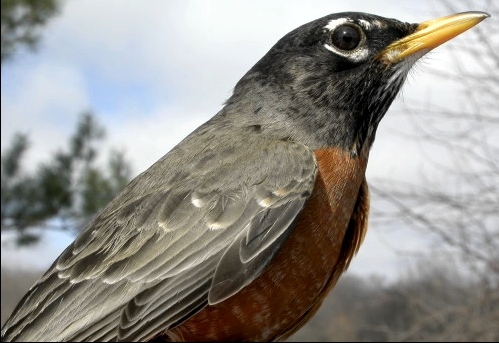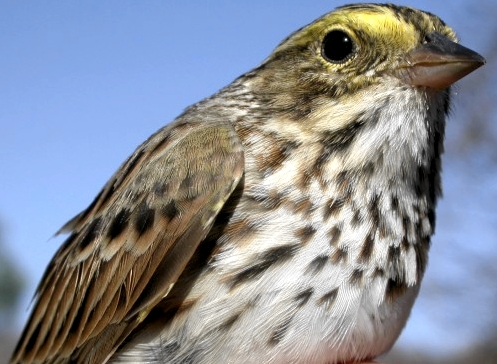Week 1: March 28 – April 3, 2006
MBO gratefully acknowledges the financial support provided for the 2006 Spring Migration Monitoring Program by the James L. Baillie Memorial Fund of Bird Studies Canada
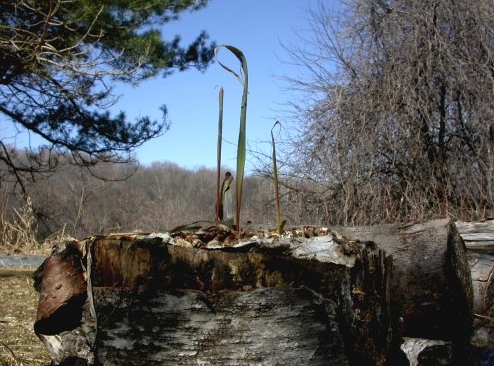
In this first week of early spring, these grass blades sprouting vigorously from one of the stumps just outside our banding cabin are a fitting symbol of the season. (Photo by Marcel Gahbauer)
| THIS WEEK | THIS SPRING | 2006 TOTAL | SITE TOTAL | |
| # birds (and species) banded | — | — | 143 (15) | 5196 (93) |
| # birds (and species) repeat | — | — | 91 (5) | 984 (41) |
| # birds (and species) return | — | — | 21 (5) | 99 (15) |
| # species observed | 37 | 37 | 48 | 172 |
| # net hours | — | — | 97 | 6519.1 |
| # birds banded / 100 net hours | — | — | 147.4 | 79.6 |
Bander-in-charge: Marcel Gahbauer
Assistants: Shawn Craik, Christina Donehower, Kate Earl, Barbara Frei, Gay Gruner, Marie-Anne Hudson, Jeremy Labrecque, Mark O’Connor
Notes: At MBO, the seasons are defined more by the movements of birds, rather than the calendar. As such, the fall season begins at the start of August, to coincide with the onset of migration by the early warblers, and ends 13 weeks later as the late sparrows and thrushes are moving out. In spring, the endpoint is easy to identify as the first week in June, when the last northbound migrants are expected. However, the start is more difficult to define – early American Robins and Red-winged Blackbirds have already been back for a few weeks, but there’s no question that mid-March in Montreal is still more like winter than spring. The last week of March is typically when a larger number of species begin arriving, and therefore the spring season at MBO is defined as the 10-week span from March 28 through June 5. The formal Spring Migration Monitoring Program (SMMP) will operate daily this year for 60 days, from April 5 through June 3.
This week we took advantage of the beautiful sunny and warm weather to set everything up for SMMP. The 11 core nets have been erected for the season, we’ve done a good burst of spring cleaning inside, and we’ve started to apply gravel and boardwalks to the wettest parts of the site to make the walking safer and easier for everyone. Plenty of work remains to be done as the season progresses, but it’s a good start at least.
The birds have already been streaming in over the past week, with new species added to the yearly checklist almost daily. Sunday was the best day, with 32 species recorded on census alone, including 4 new arrivals for the year – Winter Wren, Brown-headed Cowbird, Common Grackle, and Fox Sparrow. At least two Eastern Phoebes have already been on territory for a few days, and Song Sparrows have been increasing exponentially (the first one on Wednesday, 2 on Thursday, 4 on Friday, 8 on Saturday, and 17 on Sunday). Also of note, at least 9 Wood Ducks are scoping out the newly enlarged back pond, and a pair of Canada Geese seems to have already scoped out a territory in there too. The local Red-shouldered Hawk has been circling low and calling almost daily, and there have been as many as three others circling above him at once. Last but certainly not least, we had MBO’s second ever Bald Eagle sighting on Friday, a fourth-year bird with an almost white tail and head.
Week 2: April 4-10, 2006
| THIS WEEK | THIS SPRING | 2006 TOTAL | SITE TOTAL | |
| # birds (and species) banded | 17 (10) | 17 (10) | 160 (22) | 5213 (93) |
| # birds (and species) repeat | 7 (3) | 7 (3) | 98 (6) | 984 (41) |
| # birds (and species) return | 7 (2) | 7 (2) | 28 (7) | 99 (15) |
| # species observed | 48 | 54 | 55 | 172 |
| # net hours | 169.3 | 169.3 | 266.3 | 6688.4 |
| # birds banded / 100 net hours | 10 | 10 | 60 | 77.9 |
Banders-in-charge: Marcel Gahbauer, Marie-Anne Hudson
Assistants: Pierre Bannon, Susan Black, Martin Bowman, Shawn Craik, Jean Demers, Sarah Fraser, Barbara Frei, Gay Gruner, Marie-Anne Hudson, Irène Lepine, Barbara MacDuff, Don MacDuff, Francine Marcoux, Mike Mayerhofer, Betsy Mcfarlane, Chris Murphy, Clémence Soulard
Notes: Though the weather was unseasonably cold for several days, we nonetheless saw a noticeable advance of migration in this second week of the spring season, with the cumulative list of species observed for the season jumping by 16 species. Among the new arrivals were Yellow-bellied Sapsucker, Northern Flicker, Belted Kingfisher, Tree Swallow, and Swamp Sparrow. The daily species totals have been creeping up, with a high of 37 on Sunday.
The spring banding season began on on April 5, and will continue for 60 days. The first week of banding has been extremely quiet – relatively few migrants have returned yet, plus cold and/or wind severely restricted the operation of the nets most days. In fact, on our first day of the season, we had 2 cm of fresh snow on the ground, and spent the first half of the morning thawing out the nets! Though we would have wished for more bird activity, this result in itself is informative, and is something we can take into account when refining the spring program for next year.
Although relatively few birds were caught, a number of them were notable. On Sunday, we banded a Pileated Woodpecker for only the second time in MBO’s history. The two Golden-crowned Kinglets we banded on Friday doubled the meagre total from spring 2005 – they are a very early migrant, and one of the species that we have a better chance of documenting by starting as the earliest migrants begin to return. A female House Sparrow banded this week had one entirely white tail feather, and also a white primary covert – in each case, the third one from the outer edge on the right side!
One thing we are looking forward to this spring is an increase in our number of “returns”, i.e. banded birds that we have not captured in over three months. We expect that a number of the breeding individuals we banded last year will return, and that perhaps we will even recapture some of the young birds hatched at MBO last year. Already this week we have had several Song Sparrow returns, including a couple of individuals back for at least their third year, as we banded them in our first fall season, 2004.
Other wildlife sighting over the past week have been varied. Deer have been around a few times, and at least one muskrat is being seen quite regularly. The spring peepers have amazed us by vocalizing even when the temperature is below freezing, though they have certainly been much more vocal on warmer days, and are being joined to some extent by wood frogs. Unfortunately we’ve also had our first mosquito sightings (or more accurately, bitings) of the year, and with water levels the way they are, this is probably something we’ll have to get used to this year.
Week 3: April 11-17, 2006
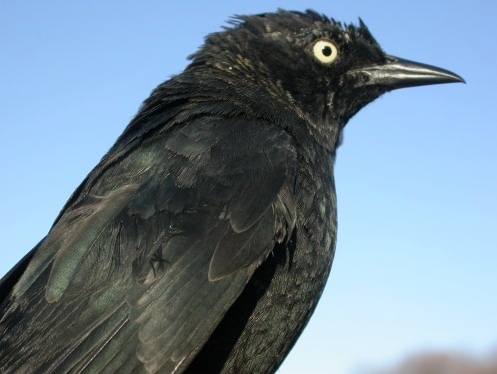
This Rusty Blackbird, banded on Friday morning, was the only one of its species observed at MBO this week, and only the third one ever banded here. (Photo by Marcel Gahbauer)
| THIS WEEK | THIS SPRING | 2006 TOTAL | SITE TOTAL | |
| # birds (and species) banded | 69 (20) | 86 (22) | 229 (28) | 5282 (93) |
| # birds (and species) repeat | 8 (5) | 15 (6) | 106 (8) | 992 (41) |
| # birds (and species) return | 9 (3) | 16 (4) | 37 (8) | 108 (15) |
| # species observed | 53 | 61 | 63 | 172 |
| # net hours | 314 | 483.3 | 580.3 | 7002.4 |
| # birds banded / 100 net hours | 22 | 17.8 | 39.5 | 75.4 |
Banders-in-charge: Marcel Gahbauer, Marie-Anne Hudson
Assistants: Pierre Bannon, Jean Beaudreault, Susan Black, Martin Bowman, Shawn Craik, Jean Demers, Sarah Fraser, Barbara Frei, Gay Gruner, Marie-Anne Hudson, Lance Laviolette, Irène Lepine, Francine Marcoux, Mike Mayerhofer, Betsy Mcfarlane, Chris Murphy, Mark O’Connor, Limoilou Renaud, Katleen Robert, Amelie Rousseau, Audrey Wachter
Notes: Our second full week of banding was considerably more productive than our first, though still slow by usual MBO standards. At this point in migration, many species have still only begun to trickle in, so the somewhat low numbers are to be expected. Nonetheless, there were again a number of highlights this week, including our third ever Rusty Blackbird in the nets, and our first morning of the season with 10 species banded.
New arrivals continued to show up almost daily, with another 7 species added to the season total this week (Double-crested Cormorant, American Bittern, Northern Harrier, American Kestrel, Belted Kingfisher, Ruby-crowned Kinglet, and Evening Grosbeak). Proof of migration advancing is that the 53 species observed during the past week nearly matches the total for the year to date at the start of the week! Of these species, 20 were observed each day this week, and another half dozen were missed just once. The large flocks of Canada Geese continue to dominate in numbers, flying past us each morning in flocks of dozens or even hundreds, but blackbirds, robins, and sparrows have been moving in flocks this week as well.
| This week’s Top Ten | |
| # individuals banded | mean # individuals observed daily |
| Slate-coloured Junco (20) | Canada Goose (753) |
| American Robin (6) | Ring-billed Gull (78) |
| Golden-crowned Kinglet (5) | Red-winged Blackbird (57) |
| Fox Sparrow (5) | American Crow (27) |
| Song Sparrow (5) | American Robin (23) |
| Ruby-crowned Kinglet (4) | Slate-coloured Junco (22) |
| Red-winged Blackbird (4) | Song Sparrow (21) |
| American Tree Sparrow (4) | Mallard (12) |
| Eastern Phoebe (3) | Brown-headed Cowbird (11) |
| Brown-headed Cowbird / American Goldfinch (2) | House Sparrow (10) |
As shown in the table above, Slate-coloured Juncos were the dominant bird of the week in the nets, accounting for nearly 30% of all birds banded. In this week alone, we quadrupled the number of juncos banded in spring 2005, largely thanks to banding occurring daily this year, rather than a few times per week last year. In fact, though numbers have been low, we have already matched or exceeded the 2005 spring banding totals for nine other species (Pileated Woodpecker, Eastern Phoebe, Blue Jay, Black-capped Chickadee, Golden-crowned Kinglet, Brown Creeper, American Tree Sparrow, Rusty Blackbird, and House Sparrow).
The relatively low volume of birds early in the season makes it a great time to get some much-needed site maintenance work done. The main effort was a 12-hour session under beautiful sunny skies on Friday, during which we moved in over 60 wheelbarrow loads of gravel from the road to line the wet sections of the trails. We also got the last of our 30 bluebird boxes in place and cleaned out, and over the course of the weekend put up 4 new Wood Duck boxes. The latter don’t seem to have been immediately adopted, but some of the bluebird boxes were being investigated by Tree Swallows or House Sparrows within minutes of being installed. Last but not least, Holly Bockus and five students from the Community Recreation and Leadership Program at Dawson College built the frame for a “j-trap” that we will use to increase our capture success for blackbirds. Thank you to everyone who helped out with the site work this week, especially to those who delivered many back-aching loads of gravel with the wheelbarrows!
Again this week, other wildlife has been abundant. As many as 5 deer have been seen together, a fox was seen on at least two mornings, and a couple of very well-fed raccoons have been spotted rambling around at various times. The most interesting mammal sighting of the week though was a very bold and curious little weasel in one of the wood piles along the back pond. During the course of some digging on Friday, three blue-spotted salamanders were unearthed. Meanwhile, the spring peeper chorus grew louder throughout the first few days of the week, to the point where it was truly painful to the ears to be near the ponds in the late afternoon! The wood frogs also became more vocal and active at the same time, and on Friday a number of them were seen hopping around as mated pairs.

A pair of wood frogs caught in a private moment as they hopped across the path at net C1. (Photo by an accidentally voyeuristic Marcel Gahbauer)
Week 4: April 18-24, 2006
| THIS WEEK | THIS SPRING | 2006 TOTAL | SITE TOTAL | |
| # birds (and species) banded | 79 (16) | 165 (26) | 308 (32) | 5361 (94) |
| # birds (and species) repeat | 6 (3) | 21 (7) | 112 (9) | 998 (41) |
| # birds (and species) return | 6 (5) | 22 (6) | 43 (10) | 114 (15) |
| # species observed | 60 | 71 | 73 | 172 |
| # net hours | 353 | 836.3 | 933.3 | 7355.4 |
| # birds banded / 100 net hours | 22.4 | 19.7 | 33 | 72.9 |
Banders-in-charge: Marcel Gahbauer, Marie-Anne Hudson
Assistants: Shawn Craik, Jean Demers, Cheryl Diamond, Christina Donehower, Barbara Frei, Gregor Gilbert, Gay Gruner, Bana Hamze, Irène Lepine, Barbara Macduff, Don Macduff, Francine Marcoux, Mike Mayerhofer, Betsy Mcfarlane, Lynn Miller, Chris Murphy, Bob Oligny, Julie Pépin, Limoilou Renaud, Katleen Robert, Clémence Soulard, Audrey Wachter, Guillaume Wachter
Notes: Although no big waves of migrants have arrived yet, there continue to be almost daily signs of the season advancing. Another 10 species made their first appearance of the year this week: Common Loon, American Black Duck, Osprey, Sharp-shinned Hawk, Virginia Rail, Great Black-backed Gull, Barn Swallow, Chipping Sparrow, Savannah Sparrow, and House Finch. Several of these are species that have been in the general area since the beginning of the spring season, but just haven’t been spotted from MBO during that time. The next big push of passerine migrants appears to have been stalled by a persistent high pressure system from the north that was present for most of the past week. Another weaker system from the north is moving in for the start of next week, but after that we can expect to see a bigger influx of passerine migrants.
This week’s banding highlight was our first ever Savannah Sparrow, caught in the ever-productive net A1. The dominant birds of the week though were Red-winged Blackbirds and Ruby-crowned Kinglets, both caught in much larger numbers than last week. We’ve also had a couple of Red-winged Blackbird returns, banded here last spring. White-throated Sparrow and American Goldfinch numbers are beginning to increase, and will likely become much more abundant over the next couple of weeks, if last year’s patterns hold true.
| This week’s Top Ten | |
| # individuals banded | mean # individuals observed daily |
| Red-winged Blackbird (18) [7] | Canada Goose (898) [1] |
| Ruby-crowned Kinglet (15) [6] | Ring-billed Gull (51) [2] |
| Slate-coloured Junco (9) [3] | Red-winged Blackbird (46) [3] |
| Song Sparrow (7) [5] | American Crow (35) [4] |
| White-throated Sparrow (6) [-] | Slate-coloured Junco (24) [6] |
| American Goldfinch (4) [10] | American Robin (22) [5] |
| American Robin (3) [2] | Mallard (20) [8] |
| Fox Sparrow (3) [4] | Song Sparrow (19) [7] |
| Swamp Sparrow (3) [-] | Brown-headed Cowbird (13) [9] |
| Downy Woodpecker (3) [-] | Northern Pintail (12) [-] |
In terms of observations, there has been remarkably little change in the most abundant species between this week and last. The daily flights of many hundreds of Canada Geese continue, large numbers of Ring-billed Gulls and American Crows are milling about daily (chiefly on the adjacent field), and there is still a strong migration underway for Red-winged Blackbirds, Slate-coloured Juncos, American Robins, and Brown-headed Cowbirds. With one exception, the species listed above were among the 22 seen each day over the past week. However, twice this week, large flocks of over 30 Northern Pintails were observed, along with smaller numbers on a couple of other days, vaulting them into this week’s top ten. Though not quite abundant enough to make the list above, Fox Sparrows have continued to be numerous throughout the week, with many of them in full song. However, American Tree Sparrows appear to be on the verge of disappearing for the season, and the sighting of the Northern Shrike on the first day of the week appears to have been our last.
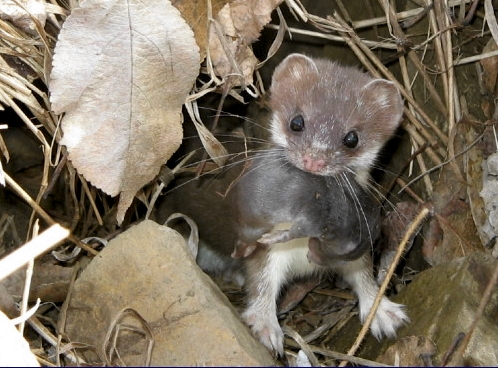
Interesting wildlife sightings continued this week, most notably this Shorttail Weasel moving
her young from one urrow to another near the banding station. (Photo by Marie-Anne Hudson)
Week 5: April 25 – May 1, 2006

An imposing beak, not to be trifled with. With 9 Common Grackles banded this week, a few of us were given a quick reminder of the special challenges of working with these rather large and sometimes aggressive birds. (Photo by Marcel Gahbauer)
| THIS WEEK | THIS SPRING | 2006 TOTAL | SITE TOTAL | |
| # birds (and species) banded | 78 (13) | 243 (29) | 386 (35) | 5439 (94) |
| # birds (and species) repeat | 16 (6) | 37 (11) | 128 (13) | 1014 (41) |
| # birds (and species) return | 8 (5) | 30 (7) | 51 (11) | 122 (15) |
| # species observed | 63 | 80 | 82 | 174 |
| # net hours | 386.9 | 1223.2 | 1320.2 | 7742.3 |
| # birds banded / 100 net hours | 20.2 | 19.9 | 29.2 | 70.2 |
Banders-in-charge: Marcel Gahbauer, Marie-Anne Hudson, Barbara Frei
Assistants: Lise Amarasakera, Lina Bardo, Jean Beaudreault, Christine Bedra, Susan Black, Shawn Craik, Jean Demers, Cheryl Diamond, Christina Donehower, Manon Dubé, Gay Gruner, Patrick-Jean Guay, Isabel Julian, Irène Lepine, Barbara Macduff, Don Macduff, Francine Marcoux, Betsy Mcfarlane, Chris Murphy, Limoilou Renaud, Katleen Robert, Clémence Soulard
Notes: We have now had prevailing north winds for nearly three weeks, and as a result migration has been reduced to a trickle. We did add another 9 species to the season list over the past week, including 6 on Sunday alone, but generally we have been seeing only a few solitary “advance scouts” rather than actual flocks of migrants. This week’s newcomers were American Wigeon (MBO’s first ever, a pair in the back pond), Black-crowned Night Heron, American Pipit, Brown Thrasher, Hermit Thrush, Blue-headed Vireo, Pine Warbler (another first ever for MBO), Yellow-rumped Warbler, and Purple Finch. We know from reports not far to the south that many more warblers are likely to arrive with the next south winds, and we are eagerly anticipating them.
Without question, it was a week dominated by blackbirds and sparrows. Red-winged Blackbirds alone accounted for nearly 45% of the birds banded. This coincided with a noticeable increase in their numbers this week, as females began arriving in good numbers. Among them was one that we banded here in May 2004. Meanwhile, male grackles have arrived in bulk, but we have yet to observe any females. Ruby-crowned Kinglets and White-throated Sparrows have also been gradually increasing, while the daily Canada Goose and Ring-billed Gull flights, although still considerable, are tapering off. We are probably seeing our last few Fox Sparrows these days, and it appears the American Tree Sparrows have already all departed.
On the whole, it felt like a very quiet week. The number of birds banded remained virtually static from last week, and the number of species observed over the course of the week increased by only three, a small increment in mid-spring. However, flora and other fauna are becoming much more prominent even if the birds aren’t at the moment. Butterflies observed this week include Cabbage White, Black Swallowtail, and a fleeting glimpse of a probable Eastern Comma. Meanwhile, the sugar maples have sprouted their leaves, and several flowers including trout lily and bloodroot have started to bloom.
| This week’s Top Ten | |
| # individuals banded | mean # individuals observed daily |
| Red-winged Blackbird (35) [1] | Canada Goose (541) [1] |
| Slate-coloured Junco (14) [3] | Red-winged Blackbird (79) [3] |
| Common Grackle (9) [-] | American Crow (37) [4] |
| White-throated Sparrow (4) [5] | Ring-billed Gull (35) [2] |
| Ruby-crowned Kinglet (3) [2] | Slate-coloured Junco (25) [5] |
| House Sparrow (3) [-] | Mallard (20) [7] |
| American Goldfinch (2) [6] | Common Grackle (19) [-] |
| American Robin (2) [7] | Northern Pintail (17) [10] |
| Swamp Sparrow (2) [7] | Tree Swallow (16) [-] |
| Four species tied at 1 each | Song Sparrow (15) [8] |
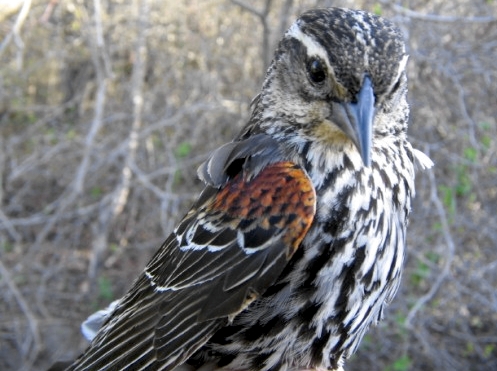
This female Red-winged Blackbird, recaptured this week, was one of the very first birds banded at MBO when we tested out nets in early May 2004. She was an after-second-year bird at that time, which means that she is now at least 4 years old. (Photo by Marie-Anne Hudson)
Week 6: May 2-8, 2006
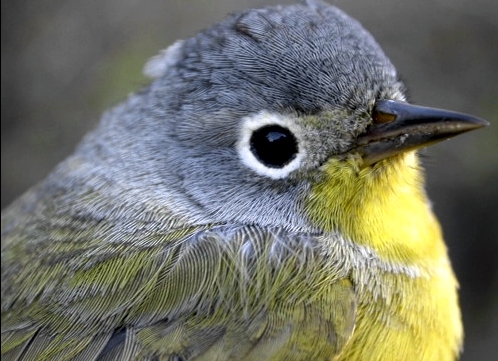
One of only three warblers banded at MBO so far this spring, this female Nashville Warbler was caught early on Friday morning. (Photo by Marcel Gahbauer)
| THIS WEEK | THIS SPRING | 2006 TOTAL | SITE TOTAL | |
| # birds (and species) banded | 148 (23) | 391 (33) | 534 (39) | 5587 (94) |
| # birds (and species) repeat | 14 (10) | 51 (11) | 142 (13) | 1028 (41) |
| # birds (and species) return | 7 (6) | 37 (10) | 58 (14) | 129 (17) |
| # species observed | 80 | 100 | 102 | 174 |
| # net hours | 463.9 | 1687.1 | 1784.1 | 8206.2 |
| # birds banded / 100 net hours | 31.7 | 23.1 | 29.9 | 68.1 |
Banders-in-charge: Marcel Gahbauer, Marie-Anne Hudson, Barbara Frei
Assistants: Pierre Bannon, Jean Beaudreault, Averill Craig, Shawn Craik, Steven Dedesko, Jean Demers, Manon Dubé, Gay Gruner, Patrick-Jean Guay, Mike Mayerhofer, Betsy Mcfarlane, Chris Murphy, Julie Pépin, Katleen Robert, Clémence Soulard
Notes: Although the main push of warblers, vireos, and flycatchers is yet to come, the past week has been marked by a considerable spike of new migrants. In total, 20 species were observed for the first time this year, including 7 new species on May 4 alone. The 80 species observed over the course of the week is also a considerable jump over last week’s 63 (and equals the season-to-date total as of the end of last week!). Many of these, however, were represented by lone individuals, as our daily totals hovered between 47 and 50 species for most of the week. The new arrivals included two sandpipers (Greater Yellowlegs and Solitary Sandpiper), five warblers (Nashville, Yellow, Palm, Black-and-white, and Common Yellowthroat), and an assortment of other passerines including Eastern Kingbird, Wood Thrush, Warbling Vireo, Rose-breasted Grosbeak, and Baltimore Oriole.
The highlight of the week was a spectacular raptor migration around closing time on Thursday. Within a span of less than half an hour, over 40 individuals of at least 7 species (some were too high to identify) streamed past, including 13 Red-tailed Hawks, 9 Ospreys, 9 Red-shouldered Hawks, 2 Broad-winged Hawks, 2 Golden Eagles (our first ever in spring), 1 Bald Eagle, and 1 Peregrine Falcon! This is an unusually late date for some of these species, most notably the Red-shouldered Hawks and Golden Eagles, suggesting that even raptors have been somewhat held back by the weather system we’ve been experiencing over the past month.
The number of birds banded this week nearly doubled compared to last week, but the nets were dominated by four species, accounting for nearly 80% of all birds banded. Topping the list for a third straight week are Red-winged Blackbirds, with this week’s additions bringing the season total to 99. A second wave of Ruby-crowned Kinglets moved through early in the week, vaulting them back into second place for the week with 32. Common Grackles came in third again, a surprise since this week alone we banded more of them than in all of spring 2005! White-throated Sparrows increased considerably in abundance this week, though they are still not as abundant as they were at the peak of their migration last spring. This week the White-throated Sparrow became the first species of which we’ve banded more than 500 individuals at MBO. All other species banded this week were much less numerous, with three or fewer individuals.
Also of note this week was our first foreign recovery of spring, a male Ruby-crowned Kinglet banded at Tommy Thompson Park in Toronto in October 2005.
| This week’s Top Ten | |
| # individuals banded | mean # individuals observed daily |
| Red-winged Blackbird (42) [1] | Snow Goose (582) [-] |
| Ruby-crowned Kinglet (32) [5] | Canada Goose (251) [1] |
| Common Grackle (24) [3] | Ring-billed Gull (97) [4] |
| White-throated Sparrow (18) [4] | Red-winged Blackbird (41) [2] |
| American Goldfinch (3) [7] | Common Grackle (35) [7] |
| American Robin (3) [7] | American Crow (27) [3] |
| Blue Jay (3) [-] | White-throated Sparrow (17) [-] |
| Brown-headed Cowbird (3) [-] | Ruby-crowned Kinglet (16) [-] |
| White-crowned Sparrow (3) [-] | Tree Swallow (15) [9] |
| Northern Cardinal (2) [-] | Song Sparrow (14) [10] |

A couple of patches of Jack-in-the-pulpit have emerged along the census trail over the past week, along with yellow and purple violets, red and white trilliums, lungwort, and trout lilies adding colour to the forest floor. (Photo by Marcel Gahbauer)
Week 7: May 9-15, 2006
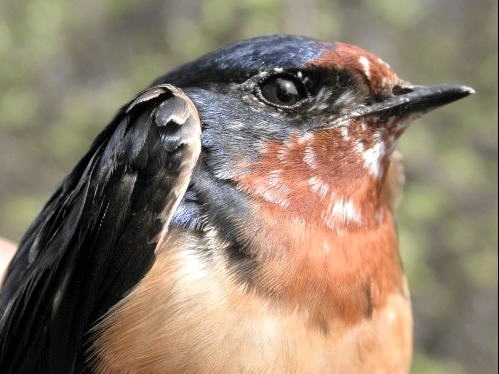
Barn Swallow, a new addition this week to our all-time list of species banded at MBO. (Photo by Marcel Gahbauer)
| THIS WEEK | THIS SPRING | 2006 TOTAL | SITE TOTAL | |
| # birds (and species) banded | 88 (23) | 479 (39) | 622 (45) | 5675 (95) |
| # birds (and species) repeat | 22 (8) | 73 (14) | 164 (15) | 1050 (41) |
| # birds (and species) return | 8 (5) | 45 (12) | 66 (15) | 137 (20) |
| # species observed | 85 | 118 | 120 | 174 |
| # net hours | 319.5 | 2006.6 | 2103.6 | 8525.7 |
| # birds banded / 100 net hours | 27.5 | 23.8 | 29.6 | 66.6 |
Banders-in-charge: Marcel Gahbauer, Marie-Anne Hudson, Barbara Frei
Assistants: Pierre Bannon, Martin Bowman, Jean Demers, Cheryl Diamond, Manon Dubé, Gay Gruner, Carine Lecoeur, Mona Mahbod, Mike Mayerhofer, Betsy Mcfarlane, Alexander McNeil, Lynn Miller, Julia Mlynarek, Chris Murphy, Limoilou Renaud, Katleen Robert
Notes: Weather continues to be a major influence on our observations, only this week it was in the form of several rainy days, rather than the persistent north winds we were experiencing until recently. As a result, while no day was entirely rained out, our banding effort for the week was curtailed considerably. As the rain was generally cold, it didn’t even bring in much in the way of new migrants. So, while it is now mid-May, and many species have started to trickle in slowly, we have yet to observe even a moderately impressive wave of passerine migration this year. However, the apple trees are now in full bloom and the rest of the vegetation is growing at a tremendous rate thanks to the rain, so it is feeling very much like spring even if the bird song isn’t quite up to par yet.
The list of 18 new species that did arrive over the past week is an eclectic one. Our first Rough-legged Hawk of spring was perhaps the biggest surprise, as they are usually a very early migrant. Passing overhead later the same morning were another Golden Eagle and a Bald Eagle being attacked by a Merlin, so it had company among the late raptor migrants. Other new species included 8 more species of warbler, plus Northern Shoveler, Spotted Sandpiper, Ruby-throated Hummingbird, Least Flycatcher, Great-crested Flycatcher, and Bobolink. For the week, we observed 85 species, with a single-day high of 55 on Monday.
While it was overall still a rather quiet week, the raptor flight was just one of several memorable moments. Another particularly remarkable one occurred on Tuesday morning, when a Barn Swallow flew in through the open door of the banding station while we were inside processing a Song Sparrow! No doubt it was exploring potential nesting sites, but when it saw us inside it was startled and flew into one of the windows. Fortunately it was only momentarily stunned, and so we banded it before releasing it back outside … at least if this one comes back we’ll be able to recognize him! It became our 95th species banded at MBO – see the updated checklist for current totals.
The Canada Geese have produced the first young birds of the year at MBO, with their goslings being spotted for the first time on Saturday morning. It appears that while we were fixated on the unsuccessful roof-nesting goose in the back pond, another much more secretive pair was on a nest in Stoneycroft Pond. Also this week we noticed the first eggs of the year in the nest boxes (only House Sparrows so far), and there are active Northern Cardinal, Red-winged Blackbird, and American Robin nests under observation as well. Based on the documentation of brood patches during banding, it appears that at least a few Common Grackles and Song Sparrows have begun to nest too.
Our banding rate was similar to last week, but the totals were down due to the rain. Red-winged Blackbirds yet again were the most frequently banded species, bringing their season total to 124 (just over 25% of our season total of all birds!). Common Grackles remained common too, and we continued to band modest numbers of American Goldfinch and White-throated Sparrow. Most of the rest of this week’s top ten are new arrivals, including three species of warbler, plus Rose-breasted Grosbeak, Baltimore Oriole, and Tree Swallow.
| This week’s Top Ten | |
| # individuals banded | mean # individuals observed daily |
| Red-winged Blackbird (25) [1] | Ring-billed Gull (99) [3] |
| Common Grackle (14) [3] | Red-winged Blackbird (50) [4] |
| American Goldfinch (8) [5] | Cliff Swallow (37) [-] |
| White-throated Sparrow (7) [4] | Mallard (30) [-] |
| Yellow-rumped Warbler (5) [-] | American Crow (28) [6] |
| Yellow Warbler (3) [-] | Tree Swallow (25) [9] |
| Baltimore Oriole (3) [-] | Common Grackle (24) [5] |
| Rose-breasted Grosbeak (2) [-] | American Goldfinch (21) [-] |
| Nashville Warbler (2) [-] | Yellow Warbler (12) [-] |
| Tree Swallow (2) [-] | Song Sparrow (11) [10] |
There was considerable turnover this week in the species most frequently observed. The Canada Goose migration came to an abrupt end late last week, and with only the resident two pairs around this week, they dropped entirely out of the top ten. Ring-billed Gull numbers barely changed since last week, but they became the most numerous species this week with the disappearance of the Canada and Snow Goose flocks. A few Cliff Swallows were seen last week already, but this week numbers shot up as they were attracted to a hatch of midges over Stoneycroft Pond midweek. Common Grackle numbers are tapering off a bit, but surprisingly Red-winged Blackbirds continue to increase, and small flocks of migrants are still being seen. White-throated Sparrows and Ruby-crowned Kinglets largely disappeared this week, while Yellow Warblers and American Goldfinches have increased enough to break into this week’s top ten.
Again, not a single Cedar Waxwing was seen all week – will they show up at all this spring? Also notable for being overdue are Common Yellowthroats (here by May 7 last year), as well as Pied-billed Grebe and Chimney Swift, both of which were being seen regularly by mid-May in 2005. Hopefully they will all soon turn up.

This second-year male Pileated Woodpecker was spotted just beside the banding station during census, and this photo happened to catch it with its tongue extended. (Photo by Martin Bowman)
Week 8: May 16-22, 2006
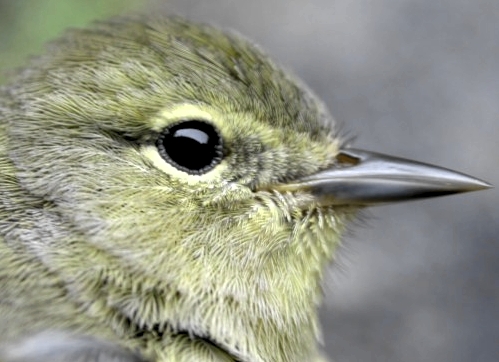
This second-year female Orange-crowned Warbler had only a couple of slightly orange-tipped
feathers in her crown. Until Sunday, this species had never been banded at MBO in spring. (Photo by Marcel Gahbauer)
| THIS WEEK | THIS SPRING | 2006 TOTAL | SITE TOTAL | |
| # birds (and species) banded | 123 (28) | 602 (52) | 745 (58) | 5798 (95) |
| # birds (and species) repeat | 25 (9) | 98 (16) | 189 (18) | 1075 (41) |
| # birds (and species) return | 13 (6) | 58 (14) | 79 (17) | 150 (21) |
| # species observed | 104 | 137 | 139 | 177 |
| # net hours | 236.2 | 2242.8 | 2339.8 | 8761.9 |
| # birds banded / 100 net hours | 52.1 | 26.8 | 31.8 | 66.2 |
Banders-in-charge: Marcel Gahbauer, Marie-Anne Hudson, Barbara Frei
Assistants: Pierre Bannon, Jean Beaudreault, Manon Dubé, Gillian Kinsman, Jeremy Labrecque, Carine Lecoeur, Mike Mayerhofer, Alexander McNeil, Lynn Miller, Chris Murphy, Katleen Robert, Kate Robinson
Notes: It was an exceptional but peculiar week at MBO. In retrospect, complaining about the rain last week was somewhat premature, as it was this week that it really came down on us relentlessly. On Saturday we were rained out entirely, and every other morning except Tuesday we lost at least some hours to rain and/or wind. In total, over 85 mm of precipitation fell during the week, with at least 5 mm each day except Monday. It was also quite cool, with daily highs ranging between 10 and 16 degrees Celsius. As a result, it was rather dreary weather to be out in, and the flooding on site is almost back up to the record levels we were seeing at the end of the spring thaw.
The amazing thing is that despite these conditions, we set several records this week. In spring 2005, we never recorded more than 64 species in a single day. This week we surpassed that mark four times, including three new records along the way – 66 on Tuesday, 72 on Thursday, and then 76 on Sunday! Included in Sunday’s total were two species we’ve never had at MBO before – Brant, and White-winged Scoter, both flying north overhead. Sunday we also banded a wider variety and greater number of birds (37 individuals of 18 species) than any other day yet this spring, though those numbers are still lower than our spring 2005 records. Other observatories further south are only now beginning to record peak numbers of birds, so an influx may yet be on the way here in the next week or two.
Perhaps the most impressive new record is the 104 species observed over the past week. This is by far the greatest diversity we’ve recorded at MBO in such a short period. Included in this were 20 warbler species, with as many as 16 of them being seen on a couple of the best days. Warblers accounted for several of the 19 new arrivals this week (Orange-crowned, Parula, Blackburnian, Bay-breasted, Wilson’s, Common Yellowthroat). Among the others were Hooded Merganser, Chimney Swift, Veery, Red-eyed Vireo, Swainson’s Thrush, Indigo Bunting, Scarlet Tanager, and Field Sparrow. The last few new migrants have already put us over last spring’s season total of 134 species.
The goose family featured last week was seen fairly regularly this week, going from end to end of Stoneycroft Pond, and even wandering up the path to the corn field near the gate. Meanwhile, we spotted the year’s first brood of Wood Ducks on Sunday morning – ten little ones probably no more than a couple of days old, rushing after mom at the north end of Stoneycroft Pond.
Among the banding highlights this week were Orange-crowned Warbler, Cape May Warbler, and Field Sparrow, none of which we’ve banded in spring before. Ten warbler species were banded, with some common species still missed so far, and hopefully yet to find the nets next week. Overall 13 species were banded for the first time this year. The Red-winged Blackbirds managed to hold on to the top spot for yet another week, but the next few spots are now occupied by warblers, and there are some new arrivals among the top ten, including Common Yellowthroat and Gray Catbird. Our 600th bird of the season was banded at the end of Monday morning (correction: 595, plus 5 from a counting error!).
| This week’s Top Ten [last week’s rank in brackets] | |
| # individuals banded | mean # individuals observed daily |
| Red-winged Blackbird (19) [1] | Red-winged Blackbird (36) [2] |
| Yellow-rumped Warbler (13) [5] | American Crow (31) [5] |
| Common Yellowthroat (11) [-] | Ring-billed Gull (23) [1] |
| Magnolia Warbler (10) [-] | Mallard (19) [4] |
| Gray Catbird (7) [-] | American Goldfinch (16) [8] |
| Baltimore Oriole (6) [6] | Yellow Warbler (15) [9] |
| Common Grackle (6) [2] | Common Grackle (14) [7] |
| White-crowned Sparrow (5) [-] | Tree Swallow (13) [6] |
| Yellow Warbler (5) [6] | Yellow-rumped Warbler (11) [-] |
| Lincoln’s Sparrow (4) [-] | Song Sparrow (10) [10] |
With gull activity dropping off a bit this week, Red-winged Blackbirds moved up to top the list of species observed. Crows are also still high on the list, though except for a day when nearly 70 of them mobbed a Great Horned Owl, they have been quieter and scarcer than in recent weeks. While it was very much a week of warblers, only Yellow and Yellow-rumped were consistently seen in large enough numbers to put them in the top ten.
Two weeks of spring migration left … we are eager to see what further surprises still await us!
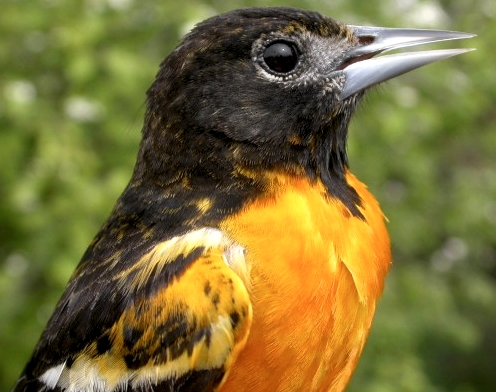
We were very happy this week to welcome back this old female Baltimore Oriole, banded along Stoneycroft Pond by Rodger Titman in 2003, a year before MBO was established. (Photo by Marcel Gahbauer)
Week 9: May 23-29, 2006
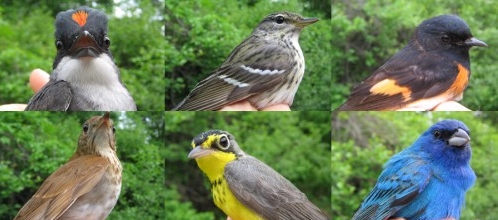
A sampling of some of our newly-banded species for this week (mounted in no particular order – we claim no favorites! Actually, there were the photos that I had on hand…): Eastern Kingbird, Blackpoll Warbler, American Redstart, Veery, Canada Warbler, and Indigo Bunting. (Photos by Marie-Anne Hudson)-
| THIS WEEK | THIS SPRING | 2006 TOTAL | SITE TOTAL | |
| # birds (and species) banded | 128 (31) | 730 (62) | 873 (68) | 5926 (95) |
| # birds (and species) repeat | 38 (15) | 136 (20) | 227 (22) | 1113 (41) |
| # birds (and species) return | 15 (10) | 73 (19) | 94 (20) | 165 (24) |
| # species observed | 99 | 148 | 150 | 178 |
| # net hours | 483.8 | 2726.6 | 2823.6 | 9245.7 |
| # birds banded / 100 net hours | 26.5 | 26.8 | 30.9 | 64.1 |
Banders-in-charge: Marcel Gahbauer, Marie-Anne Hudson, Barbara Frei
Assistants: Pierre Bannon, Jean Beaudreault, Martin Bowman, Manon Dubé, Gerard Frechette, Emily Gray, Gay Gruner, Gillian Kinsman, Betsy Macfarlane, Carine Lecoeur, Barbara MacDuff, Francine Marcoux, Mike Mayerhofer, Alexander McNeil, Lynn Miller, Chris Murphy, Julie Pépin, Crissy Ranellucci, Katleen Robert, Kate Robinson
Notes: This week was one of those weeks where you wait and wait for that big push of migrants … and nothing much happens. With winds coming from the south on 3 of the 7 days, we thought we’d be inundated with warblers and thrushes and vireos (oh my!). However this push never really materialized, leaving only a trickle of migrants. Later in the week the humidity went through the roof, quickly allowing the mosquitoes to enjoy the feast we laid out for them on a daily basis. Though we discourage the use of bug repellant for those handling birds, we suggest that a quick spray to the back of the collar and the back of the hat before leaving the house (and then washing your hands), can provide a bit of relief. These areas aren’t generally touched too much over the course of the day, allowing you to go relatively bug-free without smearing birds with bug-repellant. It’s a win-win situation
Despite the apparent trickle of birds, the DET never slipped below 55 species, with a high of 70 on Wednesday and a cumulative weekly total of 99 species. New arrivals to MBO this week (11 species) were Pied-billed Grebe (though it seems to have disappeared again), a visiting Green-winged Teal, a pair of Gadwall, a fly-by Common Merganser, a flock of Semipalmated Plovers, an almost-caught Black-billed Cuckoo, Eastern Wood-pewee, Alder and Willow Flycatchers, Blackpoll Warbler, and Canada Warbler. Of particular note for being new additions to the all-time MBO list were the Gadwall (long overdue) and the Semipalmated Plovers (a great surprise).

A highlight for this week was our fourth foreign recapture: a Traill’s Flycatcher that was
banded June 5, 2003 in Michigan landed in our nets early Saturday morning. The gray
sky only allowed a rather marginal photo to be taken of our special visitor.
(Photo by Marie-Anne Hudson)
Species diversity wasn’t too bad on the banding side as well, though last Sunday’s record (37 individuals, 18 species) is still quite safe for now with 8-13 species banded every day. Overall we banded 128 individuals representing 31 species, with newly-banded species (10 species) including Yellow-bellied Sapsucker, Eastern Kingbird, Veery, Gray-cheeked Thrush, Red-eyed Vireo, Chestnut-sided Warbler, Blackpoll Warbler, American Redstart, Canada Warbler, and Indigo Bunting.
As always, we’re eager to see what will hit the nets this coming week — our last week of the season! At this point nothing will surprise us: Barbara and Crissy walked up to the D nets only to find a female Mallard sitting in the bottom pocket, dragging the whole net down to the ground. A quick opening of the net was all she needed to fly out.
| This week’s Top Ten [last week’s rank in brackets] | |
| # individuals banded | mean # individuals observed daily |
| Red-winged Blackbird (21) [1] | Ring-billed Gull (43) [3] |
| Yellow Warbler (13) [9] | Red-winged Blackbird (38) [1] |
| Common Yellowthroat (13) [3] | Canada Goose (32) [-] |
| Wilson’s Warbler (11) [-] | Mallard (26) [4] |
| Magnolia Warbler (11) [4] | American Crow (23) [2] |
| American Goldfinch (9) [-] | American Goldfinch (22) [5] |
| Cedar Waxwing (8) [-] | Yellow Warbler (21) [6] |
| Northern Waterthrush (4) [-] | Cedar Waxwing (15) [-] |
| Common Grackle (4) [6] | Tree Swallow (13) [8] |
| Rose-breasted Grosbeak (3) [-] | Song Sparrow (11) [10] |
The Red-winged Blackbirds held onto their top spot (for a sixth straight week!) with 21 birds banded, and Yellow Warblers rocketed to second place with 13. It’s amazing to us that we have been banding for 6 weeks and we’re still banding new Red-winged Blackbirds,Yellow Warblers and Common Yellowthroats. Seems like there’s no end in sight! Another interesting addition to the weekly totals is the number of Wilson’s Warblers banded, pushing them to fourth place. The number of individuals observed daily has remained relatively stable save for the addition of Cedar Waxwings and a resurgence of Canada Geese, thanks to modest flocks flying past on a couple of mornings. With any luck the growing flocks of waxwings will hang around long enough for us to band most of them!
As always, we would like to extend a hearty thank you to all those mosquito-braving individuals who helped with census, net runs and banding – we couldn’t do it without you!
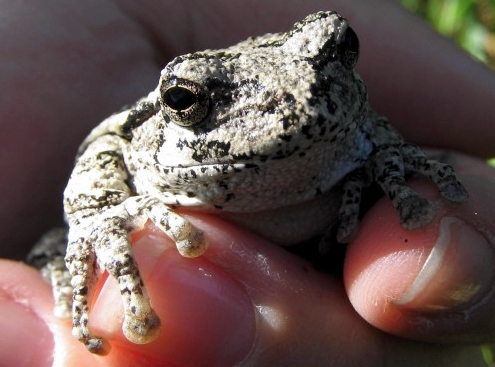
On a non-birdy note, this week the Gray Treefrogs have really been singing, competing for air-time with the Yellow Warblers, Baltimore Orioles and Song Sparrows. This little guy was found sitting quietly in the shade under a Northern Cardinal nest. (Photo by Marie-Anne Hudson)
Week 10: May 30 – June 5, 2006
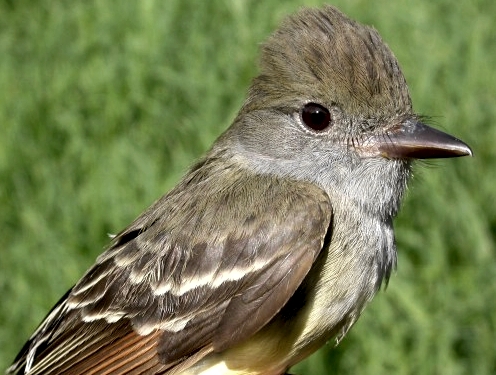
The 63rd and final species banded this spring, a Great Crested Flycatcher caught on June 2. (Photo by Marcel Gahbauer)-
| THIS WEEK | THIS SPRING | 2006 TOTAL | SITE TOTAL | |
| # birds (and species) banded | 29 (18) | 759 (63) | 902 (69) | 5955 (95) |
| # birds (and species) repeat | 8 (7) | 144 (23) | 235 (27) | 1113 (42) |
| # birds (and species) return | 2 (2) | 75 (19) | 96 (20) | 165 (25) |
| # species observed | 74 | 148 | 151 | 178 |
| # net hours | 209.9 | 2938.4 | 3033.5 | 9455.6 |
| # birds banded / 100 net hours | 13.8 | 25.8 | 29.7 | 62.9 |
Banders-in-charge: Marcel Gahbauer, Marie-Anne Hudson, Barbara Frei
Assistants: Jean Demers, Manon Dubé, Christine Gray, Emily Gray, Gay Gruner, Bana Hamze, Betsy Mcfarlane, Barbara MacDuff, Chris Murphy, Crissy Ranellucci, Katleen Robert, Clémence Soulard
Notes: Well, the spring season ended with more of a whimper than a bang, but that’s not entirely a bad thing – after all, if migration were still going strong at this point, we would be shutting down too soon. Nonetheless, it was a rather dull week, with migration dropping off very dramatically at the end of last week. Whereas last week we observed at least 55 species every day, this week we weren’t able to reach that number even once! The total number of species observed during the week also underwent a sharp decline, from 99 last week to just 74 this week, and did not include even a single new species for the season.
All the same, the final week was worthwhile as it allowed us to document the late season migrants well. Blackpoll Warbler, Yellow-bellied Flycatcher, and Black-billed Cuckoo were among the species still on the move this week. Meanwhile, the breeding season is well underway for many earlier arrivals, with young Wood Ducks already being spotted on the pond, and various other species observed nesting, including Mourning Dove, American Robin, Yellow Warbler, and Song Sparrow.
| This week’s Top Ten [last week’s rank in brackets] | |
| # individuals banded | mean # individuals observed daily |
| Cedar Waxwing (6) [7] | Red-winged Blackbird (23) [2] |
| Red-winged Blackbird (4) [1] | Canada Goose (16) [3] |
| Blackpoll Warbler (2) [-] | Yellow Warbler (15) [7] |
| Black-capped Chickadee (2) [-] | Mallard (14) [4] |
| White-throated Sparrow (2) [-] | Cedar Waxwing (13) [8] |
| American Goldfinch (13) [6] | |
| Tree Swallow (11) [9] | |
| 13 other species tied with 1 each | Song Sparrow (10) [10] |
| Ring-billed Gull (9) [1] | |
| American Crow (9) [5] |
While the number of Red-winged Blackbirds this spring more than doubled the 2005 spring total (74 to 168), this increase was offset by the dramatic drop in numbers of last year’s other top three species, American Goldfinch (111 to 32) and Cedar Waxwing (59 to 15). Others that increased notably compared to 2005 were Ruby-crowned Kinglet (20 to 55) and Slate-coloured Junco (5 to 47).
This year the bottom of the top ten was rounded out by four warbler species. The Yellow-rumped Warbler and Common Yellowthroat swapped totals and rankings between years, while Magnolia Warblers were much more numerous this spring (22 banded) than last (5). Far fewer Yellow Warblers were banded this spring, but it is worth noting that an additional 11 returns were caught, bringing the total a bit closer to what it was last year. Similarly, fewer Song Sparrows were banded this spring (20) than last (30), but once the 19 returns are factored in, we actually captured more individuals this spring.
Of the 148 species observed during the spring season, 17 of them were observed on just one day (Black-crowned Night Heron, Brant, Green-winged Teal, Northern Shoveler, American Wigeon, Hooded Merganser, Common Merganser, White-winged Scoter, Broad-winged Hawk, Rough-legged Hawk, American Kestrel, Semipalmated Plover, Spotted Sandpiper, Willow Flycatcher, Purple Martin, Bay-breasted Warbler, and Palm Warbler). At the opposite end of the spectrum, 6 species (Ring-billed Gull, American Crow, American Robin, Northern Cardinal, Red-winged Blackbird, and House Sparrow) were seen each of the 69 days that we were present, and another 8 species (Canada Goose, Wood Duck, Mallard, Eastern Phoebe, Blue Jay, Black-capped Chickadee, Song Sparrow, and American Goldfinch) were recorded on at least 65 of 69 days.
More detailed summaries and analyses of the spring data will be presented in the full seasonal report. Watch for our monthly summer updates at the end of June and July; weekly updates will resume in August.
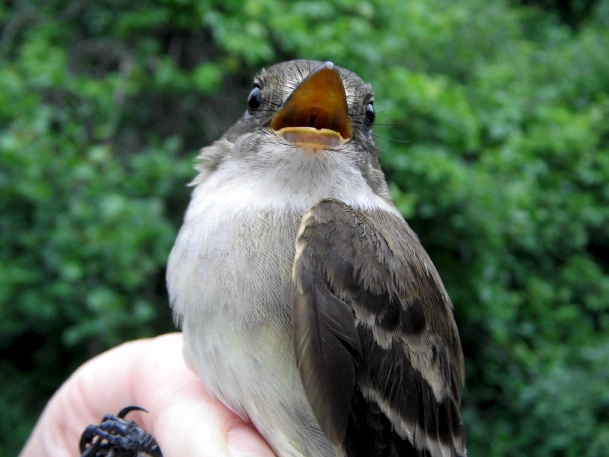
“Goodbye, and see you in the fall” … at least that’s how we translated this message! This Traill’s (probably Alder) Flycatcher was the last bird banded during the 2006 Spring Migration Monitoring Program. (Photo by Marie-Anne Hudson)
